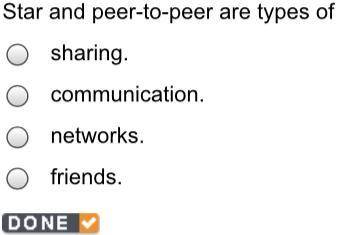Star and peer-to-peer are types of
...

Computers and Technology, 23.02.2021 18:00 preciousharrington13
Star and peer-to-peer are types of


Answers: 3


Other questions on the subject: Computers and Technology

Computers and Technology, 22.06.2019 09:00, sophiawatson70
Create a cell reference in a formula by typing in the cell name or a. right-clicking the cell. b. clicking the cell. c. clicking the column where the cell is located. d. clicking the row where the cell is located.
Answers: 1

Computers and Technology, 23.06.2019 11:30, talyku7131
Me dangers of social media and the internetexplain what each means: 1) social media and phones have become an addiction.2) outside people have access to you all the time.3) cyberstalking4) cyberbullying5) catphishing6) viruses7) identity theft8) credit card fraud9) hacking10) money schemes
Answers: 1

Computers and Technology, 23.06.2019 16:00, keyonaemanieevans
Helen is having a meeting with her colleagues in her company. they are working on the goals and objectives for the coming year. they want to ensure that these goals and objectives of the processes involved are properly evaluated. which system can helen and her colleagues apply to evaluate this? helen and her colleagues require a blank to evaluate the goals and objectives.
Answers: 2

Computers and Technology, 23.06.2019 17:30, Annlee23
When making changes to optimize part of a processor, it is often the case that speeding up one type of instruction comes at the cost of slowing down something else. for example, if we put in a complicated fast floating-point unit, that takes space, and something might have to be moved farther away from the middle to accommodate it, adding an extra cycle in delay to reach that unit. the basic amdahl's law equation does not take into account this trade-off. a. if the new fast floating-point unit speeds up floating-point operations by, on average, 2ă—, and floating-point operations take 20% of the original program's execution time, what is the overall speedup (ignoring the penalty to any other instructions)? b. now assume that speeding up the floating-point unit slowed down data cache accesses, resulting in a 1.5ă— slowdown (or 2/3 speedup). data cache accesses consume 10% of the execution time. what is the overall speedup now? c. after implementing the new floating-point operations, what percentage of execution time is spent on floating-point operations? what percentage is spent on data cache accesses?
Answers: 2
You know the right answer?
Questions in other subjects:

Mathematics, 01.11.2020 03:50


History, 01.11.2020 03:50


Chemistry, 01.11.2020 03:50

Chemistry, 01.11.2020 03:50

Mathematics, 01.11.2020 04:00

Mathematics, 01.11.2020 04:00




